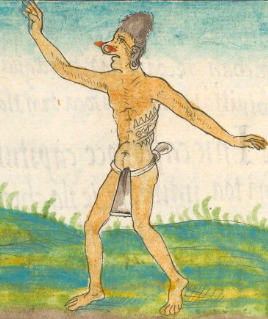tlacuilolli (FCbk9f50v)
This iconographic example, featuring a design (tlacuilolli) as body paint, is included in this digital collection for the purpose of making comparisons with related hieroglyphs. The term selected for this example comes from the keywords chosen by the team behind the Digital Florentine Codex. There is no gloss, per se, but in that field we are including a reference in Nahuatl about the body having been “painted [tattooed] across the body with obsidian serpents” (motlaquicuilo itzcohuatica). This example shows a detail of a bare male body where an obsidian serpent has been painted on the side of the abdomen. The contextualizing image shows the man in a dance-like position. He also has an unusual hairstyle, a nose ornament, and an ear plug. He may be a Cuextecatl, as suggested by the DFC keywording.
Stephanie Wood
This obsidian serpent design resonates with three glyphs in particular in this collection, which appear below with some other Itzcoatl glyphs. The personal name Tetlacuilol underlines how the obsidian serpent was a particular design, such as we see in this record.
Marc Thouvenot identifies the verb icuiloa (or ihcuiloa, with the glottal stop), which means to paint, write, or print, as having a root of -cuil-. He notes how it also appears in tlacuiloliztli (writing), tlacuilo (writer), and cuicuiltic (mottled). He goes on to show various uses of icuiloa that take it beyond the simple definitions just given, resulting in something like the action of creating a design (e.g., on leather, ceramics, sculpture, or in textiles). It can also be something like the action of decorating (e.g., to put a flower on a cup of atole). He associates icuiloa and tlacuilolli with "cultural artifacts," such as arts and crafts or examples of writing and painting, but cuicuiltic with effects created by "nature." This short summary barely does his article justice; it is worth reading the entire piece. How Thouvenot's study might connect with the concept of bent or curved mentioned by Prem (1974: 555, 682) raises an interesting question. Perhaps the bent or curved lines of writing, painting, carving, embroidery, and so on, fall with in the realm of expressions of -cuil-. See
Marc Thouvenot, "Imágenes y escritura entre los nahuas del inicio del XVI," Estudios de Cultural Náhuatl 41 (2010).
Stephanie Wood
motlaquicuilo itzcohuatica
motlaquicuilo itzcoatica
Stephanie Wood
1577
Jeff Haskett-Wood
diseños, pinturas, tatuaje, obsidiana, serpientes
tlacuilol(li), anything written or painted, a design, https://nahuatl.wired-humanities.org/content/tlacuilolli
un diseño [de pintura corporal]
Stephanie Wood
Available at Digital Florentine Codex/Códice Florentino Digital, edited by Kim N. Richter and Alicia Maria Houtrouw, "Book 9: The Merchants", fol. 50v, Getty Research Institute, 2023. https://florentinecodex.getty.edu/en/book/9/folio/50v/images/0fc2331d-26... Accessed 1 September 2025.
Images of the digitized Florentine Codex are made available under the following Creative Commons license: CC BY-NC-ND (Attribution-NonCommercial-NoDerivs 4.0 International). For print-publication quality photos, please contact the Biblioteca Medicea Laurenziana ([email protected]). The Library of Congress has also published this manuscript, using the images of the World Digital Library copy. “The Library of Congress is unaware of any copyright or other restrictions in the World Digital Library Collection. Absent any such restrictions, these materials are free to use and reuse.”





